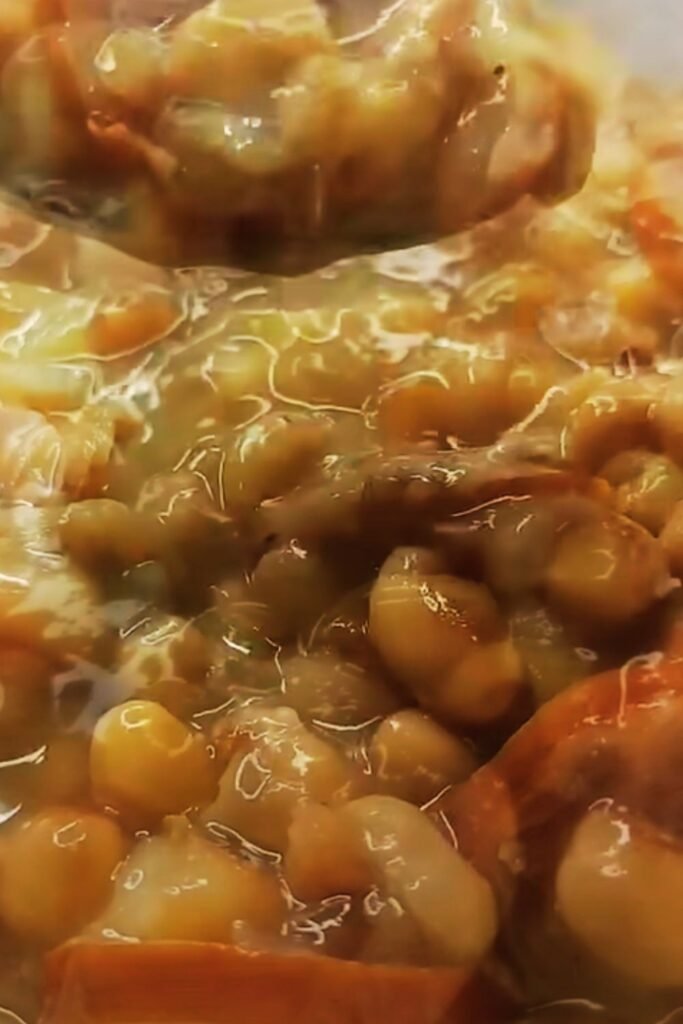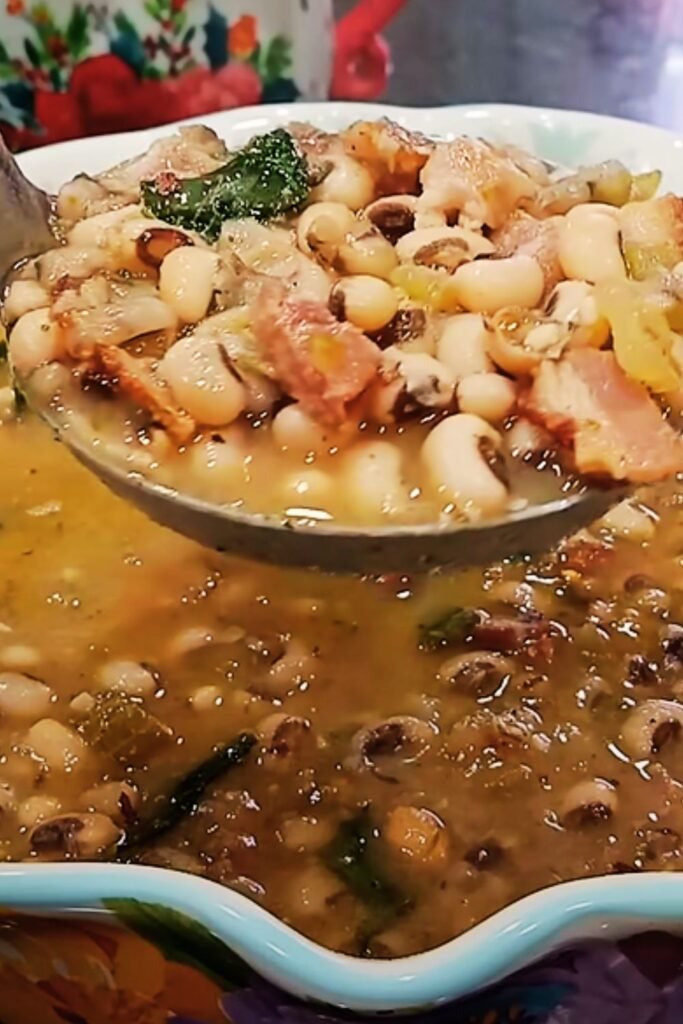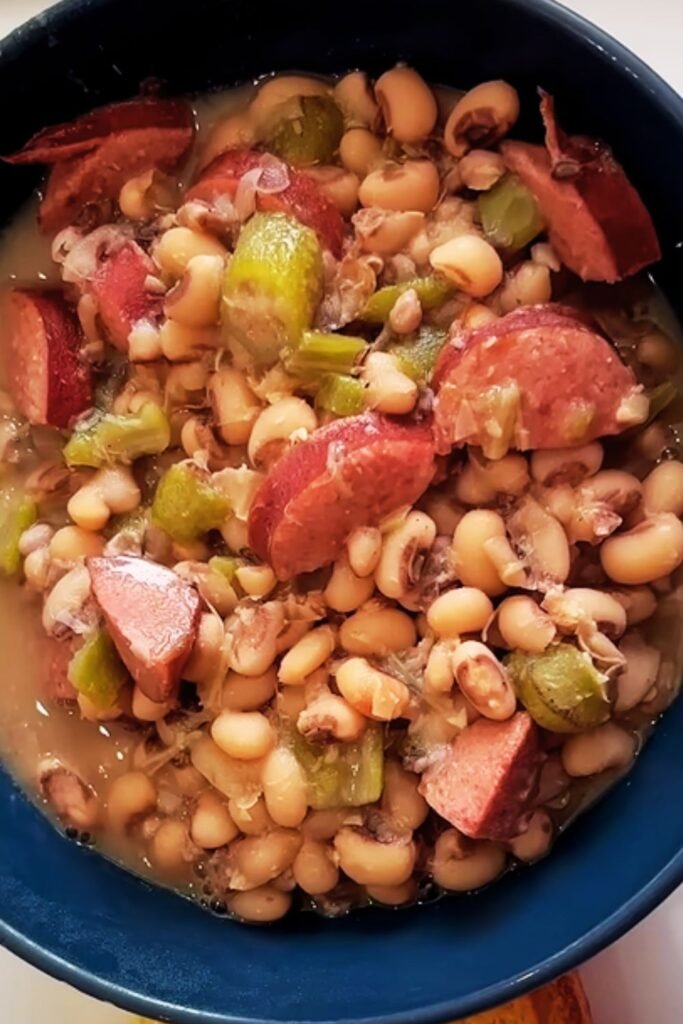Nothing beats the soul-warming comfort of a perfectly cooked pot of black-eyed peas simmered with smoky bacon and savory sausage. I’ve been making this recipe for over a decade, tweaking and perfecting it until I achieved that perfect balance of flavors that makes everyone come back for seconds. This dish isn’t just food—it’s a warm hug in a bowl that brings families together around the dinner table.
My grandmother taught me that the secret to exceptional black-eyed peas lies not just in the ingredients, but in the patience and love you put into the cooking process. This recipe combines the earthiness of black-eyed peas with the rich, smoky flavors of bacon and the hearty satisfaction of quality sausage. Every spoonful tells a story of tradition, comfort, and the kind of home cooking that nourishes both body and soul.
Understanding Your Ingredients
Black-eyed peas (Vigna unguiculata) : These aren’t actually peas at all, but rather a type of bean with a distinctive black marking that resembles an eye. They have a mild, nutty flavor and creamy texture when properly cooked.
Bacon fat rendering : The process of slowly cooking bacon to extract its fat, which becomes the flavor foundation for the entire dish. This rendered fat carries smoky, salty notes throughout every component.
Sausage selection : Quality matters enormously here. Look for sausages with natural casings and minimal fillers. Andouille, kielbasa, or smoked sausage work beautifully.
Aromatics : The holy trinity of onion, celery, and bell pepper forms the flavor base that transforms simple ingredients into something extraordinary.
The beauty of this recipe lies in how these humble ingredients work together. The bacon provides that essential smoky foundation, while the sausage adds texture and another layer of savory richness. The black-eyed peas absorb all these flavors, becoming tender vessels of comfort that practically melt in your mouth.
Complete Ingredient Breakdown
| Ingredient | Quantity | Quality Notes | Substitution Options |
|---|---|---|---|
| Dried black-eyed peas | 1 lb (16 oz) | Look for uniform size, no cracks | 3 cups canned (drained) |
| Thick-cut bacon | 8 slices | Choose artisan or butcher quality | Ham hock, turkey bacon |
| Smoked sausage | 1 lb | Andouille preferred, avoid cheap brands | Kielbasa, chorizo |
| Yellow onion | 1 large | Sweet onions work well too | 2 medium onions |
| Bell pepper | 1 large | Any color works | 2 small peppers |
| Celery stalks | 3 stalks | Include leaves for extra flavor | 1 tsp celery seed |
| Fresh garlic | 6 cloves | Avoid pre-minced | 2 tsp garlic powder |
| Bay leaves | 3 leaves | Turkish bay leaves preferred | 1 tsp dried thyme |
| Chicken stock | 8 cups | Low-sodium recommended | Vegetable broth, bone broth |
| Crushed tomatoes | 1 can (28 oz) | San Marzano for best flavor | Fresh tomatoes (3 cups) |
| Cajun seasoning | 2 tsp | Make your own or use quality brand | Individual spices |
| Smoked paprika | 1 tbsp | Spanish paprika preferred | Regular paprika + liquid smoke |
| Hot sauce | 1 tsp | Crystal or Tabasco | Cayenne pepper |
| Kosher salt | To taste | Diamond Crystal preferred | Sea salt |
| Fresh black pepper | To taste | Freshly ground only | White pepper |
My Step-by-Step Cooking Method
Initial Preparation Phase
I always start by carefully sorting through my dried black-eyed peas, spreading them out on a clean kitchen towel. This step is crucial because I need to remove any stones, damaged beans, or debris that might have made its way into the package. After sorting, I give them a thorough rinse under cold running water until the water runs completely clear.
For soaking, I place the cleaned peas in a large bowl and cover them with cool water by about 3 inches. The beans will expand significantly, so I make sure to use a bowl that’s large enough to accommodate this growth. I let them soak overnight, or for at least 8 hours, which ensures even cooking and reduces the overall cooking time.
Building the Flavor Foundation
The magic begins with rendering the bacon properly. I cut my bacon into 1-inch pieces and place them in a cold Dutch oven or heavy-bottomed pot. Starting with a cold pan allows the fat to render slowly and evenly, preventing the bacon from burning while ensuring maximum flavor extraction.

I cook the bacon over medium-low heat, stirring occasionally, until it reaches that perfect golden-brown crispiness. This process usually takes about 10-12 minutes, but I never rush it. The rendered fat is liquid gold for this recipe, and I want to extract every drop of flavor.
Once the bacon is perfectly crispy, I remove it with a slotted spoon and set it aside on a paper towel-lined plate. I leave all that beautiful rendered fat in the pot—this is what will flavor everything else.
Creating the Aromatic Base
In the same pot with the bacon fat, I add my diced onion, bell pepper, and celery. This combination, known as the “holy trinity” in Creole and Cajun cooking, forms the aromatic foundation that will permeate every bite of the finished dish.
I cook these vegetables over medium heat, stirring frequently, until they become soft and translucent. This process takes about 8-10 minutes, and I’m looking for that moment when the onions lose their sharp bite and the peppers begin to sweeten. The vegetables should be tender but not browned.
Next, I add the minced garlic and cook for another 1-2 minutes until fragrant. Garlic burns quickly, so I keep it moving and watch it carefully. When I can smell that wonderful garlicky aroma filling my kitchen, I know it’s time for the next step.
Incorporating the Sausage
I slice my sausage into rounds about 1/4-inch thick and add them to the pot with the vegetables. The goal here isn’t to fully cook the sausage—it will finish cooking with the peas—but rather to brown the edges and release some of its flavors into the mix.
I cook the sausage for about 4-5 minutes, stirring occasionally, until the pieces are lightly browned and have released some of their oils. This step adds another layer of richness to our flavor base.
The Main Event
Now comes the moment I’ve been building toward. I drain and rinse my soaked black-eyed peas, then add them to the pot along with the crispy bacon I set aside earlier. I pour in enough chicken stock to cover the peas by about 2 inches—usually around 6-8 cups, depending on my pot size.
I add the crushed tomatoes, bay leaves, Cajun seasoning, smoked paprika, and a generous pinch of salt and pepper. I bring the mixture to a rolling boil, then immediately reduce the heat to low and partially cover the pot.
The Slow Simmer Process
This is where patience becomes your greatest ally. I let the peas simmer gently for 1.5 to 2 hours, stirring occasionally and checking the liquid level. The peas should always be covered with liquid, so I add more stock or water as needed.
During this time, I taste the cooking liquid periodically and adjust the seasonings. The peas are done when they’re tender enough to mash easily with a fork but still hold their shape. They should have a creamy texture without being mushy.

Nutritional Profile and Health Benefits
| Nutrient | Per 1-Cup Serving | Daily Value % | Health Benefits |
|---|---|---|---|
| Calories | 420 | 21% | Sustained energy |
| Protein | 24g | 48% | Muscle maintenance |
| Carbohydrates | 38g | 13% | Energy source |
| Dietary Fiber | 14g | 56% | Digestive health |
| Total Fat | 20g | 31% | Nutrient absorption |
| Saturated Fat | 7g | 35% | Moderate intake |
| Sodium | 950mg | 41% | Electrolyte balance |
| Iron | 5.2mg | 29% | Oxygen transport |
| Folate | 125mcg | 31% | Cell division |
| Potassium | 520mg | 15% | Heart health |
| Magnesium | 85mg | 20% | Muscle function |
| Phosphorus | 180mg | 18% | Bone health |
Black-eyed peas are nutritional powerhouses that deserve a place in any healthy diet. They’re packed with plant-based protein, making them an excellent choice for those looking to reduce their meat consumption without sacrificing protein intake. The high fiber content supports digestive health and helps maintain steady blood sugar levels throughout the day.
While the bacon and sausage do add sodium and saturated fat, they also contribute essential B vitamins and minerals. When enjoyed as part of a balanced diet, this dish provides substantial nutritional benefits while satisfying your comfort food cravings.
Advanced Cooking Techniques and Tips
Texture Mastery
Achieving the perfect texture is an art form that took me years to master. The key is understanding that black-eyed peas need to be cooked until they’re tender but not falling apart. I test for doneness by removing a few peas from the pot and pressing them gently with a fork. They should yield easily but maintain their shape.
If your peas are cooking too quickly and starting to break apart, reduce the heat and add more liquid. If they’re taking too long to soften, check your water quality—hard water can significantly slow the cooking process.
Flavor Development Strategies
The secret to deeply flavored black-eyed peas lies in layering flavors throughout the cooking process. I don’t just dump everything in at once; instead, I build flavors gradually:
- First, I render the bacon to create a smoky fat base
- Then I sauté the aromatics to release their essential oils
- I brown the sausage to add caramelized flavors
- Finally, I add acids (tomatoes) and seasonings at the right moment
Seasoning Timing
Timing is everything when it comes to seasoning. I add salt gradually throughout the cooking process, tasting and adjusting as I go. Adding too much salt too early can prevent the peas from softening properly, while waiting too long can result in under-seasoned beans.
I always add my acidic ingredients (tomatoes) after the peas have been cooking for at least 30 minutes. Acid can interfere with the softening process, so timing is crucial.
Serving Suggestions and Pairings
This versatile dish shines as both a main course and a hearty side. I love serving it over fluffy white rice or with a slice of warm cornbread for a complete, satisfying meal. The combination of textures and flavors creates a dining experience that’s both comforting and exciting.
Traditional Southern Pairings:
- Fresh cornbread or corn muffins
- Steamed jasmine or long-grain rice
- Collard greens with smoked turkey
- Fried green tomatoes
- Buttermilk biscuits
- Coleslaw with tangy dressing
Modern Serving Ideas:
- Over quinoa for added protein
- With crusty artisan bread
- As a topping for baked sweet potatoes
- Alongside grilled vegetables
- Over creamy polenta
- With avocado slices for richness

For special occasions, I often serve this as part of a larger Southern feast alongside fried chicken, mac and cheese, and fresh greens. The combination creates a meal that celebrates the rich culinary traditions of the American South.
Storage and Reheating Guidelines
| Storage Method | Duration | Container Type | Reheating Instructions |
|---|---|---|---|
| Refrigerator | 4-5 days | Airtight container | Stovetop: low heat, add liquid if needed |
| Freezer | 3-4 months | Freezer-safe container | Thaw overnight, reheat gently |
| Room temperature | 2 hours max | Covered pot | Not recommended |
One of the beautiful things about this recipe is how well it keeps and how the flavors actually improve over time. I often make a double batch specifically for leftovers because the peas taste even better the next day after all the flavors have had time to meld together.
When reheating, I add a splash of chicken stock or water if the mixture seems too thick. I always reheat gently over low heat, stirring occasionally to prevent sticking. The key is patience—rushing the reheating process can cause the peas to break apart.
Recipe Variations and Customizations
Heat Level Adjustments
For those who prefer milder flavors, I simply reduce or eliminate the hot sauce and use sweet paprika instead of smoked. For heat lovers, I add diced jalapeños with the other vegetables or include a dash of cayenne pepper during the cooking process.
Protein Alternatives
Vegetarian Version: Replace the meat with mushrooms, extra vegetables, and vegetable broth. I add liquid smoke to maintain that smoky flavor.
Leaner Options: Use turkey bacon and chicken sausage for a lighter version that doesn’t sacrifice flavor.
Seafood Twist: Add shrimp or crab meat during the last 10 minutes of cooking for a coastal variation.
Regional Variations
Cajun Style: Increase the Cajun seasoning and add okra for authentic Louisiana flavor.
Texas Style: Include diced jalapeños, cumin, and chili powder for a Southwestern twist.
Carolina Style: Add a splash of apple cider vinegar and a touch of brown sugar for tangy sweetness.
Troubleshooting Common Issues
Problem: Peas are taking forever to cook Solution: Check if your peas are old or if you have hard water. Both can significantly increase cooking time.
Problem: Peas are mushy and falling apart Solution: Reduce heat and avoid vigorous stirring. Cook longer at lower temperature next time.
Problem: Dish tastes flat or bland Solution: Taste and adjust seasonings. Sometimes a splash of vinegar or lemon juice can brighten the entire dish.
Problem: Too salty Solution: Add more liquid and a peeled potato to absorb excess salt. Remove the potato before serving.
Questions and Answers
Q: Can I use canned black-eyed peas instead of dried ones? A: Absolutely! Use about 4 cups of drained canned peas and reduce the cooking time to 45 minutes to 1 hour. The texture won’t be quite as perfect as dried peas, but the flavor will still be delicious.
Q: How do I know when the black-eyed peas are perfectly cooked? A: The peas should be tender enough to mash easily with a fork but still hold their shape. They should have a creamy texture without being mushy or falling apart completely.
Q: Can I make this recipe in a slow cooker? A: Yes! After browning the bacon and sausage and sautéing the vegetables, transfer everything to a slow cooker. Cook on low for 6-8 hours or high for 3-4 hours. Add the tomatoes during the last 2 hours.
Q: Why are my black-eyed peas splitting during cooking? A: This usually happens when the peas are old, when you cook them at too high a temperature, or if you stir too vigorously. Gentle simmering and careful handling should prevent this.
Q: Can I freeze this dish for later? A: This recipe freezes beautifully for up to 4 months. Cool completely before freezing, and leave some room in the container for expansion. Thaw overnight in the refrigerator before reheating.
Q: What’s the best way to add more vegetables to this recipe? A: I love adding diced carrots with the other aromatics, or stirring in fresh spinach during the last 10 minutes of cooking. Root vegetables should be added early, while leafy greens go in at the end.
Q: How can I make this recipe healthier without losing flavor? A: Use turkey bacon, choose lower-sodium sausage, and increase the vegetable content. You can also use low-sodium broth and add fresh herbs like thyme or oregano for extra flavor without salt.
Q: Is it better to make this recipe ahead of time? A: This dish actually improves with time! The flavors meld beautifully overnight, making it perfect for meal prep. I often make it a day ahead and reheat gently before serving.
This black-eyed peas recipe with bacon and sausage represents everything I love about comfort food—it’s hearty, flavorful, and brings people together. Whether you’re carrying on a family tradition or starting a new one, this dish will become a treasured part of your cooking repertoire. The combination of smoky bacon, savory sausage, and tender peas creates a symphony of flavors that speaks to the soul and satisfies the appetite in the most wonderful way.